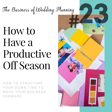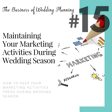Become a Creator today!Start creating today - Share your story with the world!
Start for free
00:00:00
00:00:01

How to Deal with Difficult Clients
1. Understanding the Nature of Difficult Clients
- Discussion on the various forms of difficult clients: those with unrealistic expectations, indecisiveness, overly critical behavior, or confrontational attitudes.
- Emphasis on recognizing the type of challenge at hand as the first step to effective management.
2. Dealing with Unrealistic Expectations
- Educate Your Clients: Strategies for setting realistic expectations during initial consultations using examples from past weddings.
- Offer Creative Alternatives: How to creatively satisfy client desires without exceeding their budget or logistical capabilities.
- Transparent Cost Breakdown: Importance of providing a detailed cost breakdown to help clients understand budget allocations.
- Use Visuals: Utilizing visual aids to help clients understand the impact of their choices on aesthetics and costs.
- Incremental Decision Points: Setting up incremental decision-making milestones to manage client expectations throughout the planning process.
- Scenario Simulation: Running through different scenarios to show potential outcomes and help guide client decisions.
- Regular Reassessments: The necessity of regular check-ins to adjust plans and manage expectations effectively.
3. Managing Indecisive Clients
- Provide Clear Options: Tips for presenting limited, curated options to avoid overwhelming clients.
- Set Soft Deadlines: Using soft deadlines to gently push decision-making without adding stress.
- Decision-Making Workshops: Organizing focused sessions to aid clients in making informed decisions.
- Visual Aids and Examples: How mood boards and digital simulations can aid indecisive clients.
- Incremental Decision Making: Breaking down decisions into smaller, manageable parts.
- Reinforce Positive Outcomes: The importance of reinforcing positive decisions to boost client confidence.
- Professional Support: Continuous reassurance and support throughout the decision-making process.
4. Handling Overly Critical and Confrontational Clients
- Pre-emptive Clarification: Setting clear expectations from the start to prevent misunderstandings.
- Structured Communication: Implementing a communication protocol to manage interactions and expectations.
- Active Listening: Techniques for validating client concerns and de-escalating tension.
- De-escalation Techniques: Specific phrases and strategies to calm heated situations.
- Boundary Reinforcement: How to firmly yet politely set professional boundaries.
- Solution-Oriented Mindset: Focusing on solutions rather than dwelling on problems.
5. Handling Conflict and Complaints
- Tips for staying calm and professional.
- Strategies for acknowledging client feelings and seeking solutions rather than assigning blame.
- Knowing when to draw the line with unreasonable demands.
6. Establishing Clear Communication
- Importance of setting clear expectations from the start.
- Benefits of active listening and regular updates to keep clients informed and engaged.
Sponsor Info
Transcript
00:00:00
Speaker
Today's episode is proudly brought to you by Markel Event Insurance. Markel's One Day Event Insurance is an easy and affordable solution to help ensure your client's event goes off without a hitch. With policies starting at just $75, make sure you recommend adding a Markel insurance policy to your client's wedding or special event. For further details, including how to obtain free event brochures for your business that outline the simple steps your clients need to take to secure coverage, visit markel.com slash planner.
00:00:35
Speaker
Are you a wedding planner just starting your business or have you been in the industry for just a few years? Do you want to build a profitable and enjoyable planning business that you're excited about every day? If the answer is yes, then you're in the right place. Welcome to the business of wedding planning podcast. I'm your host, Amber Peterson. I was a wedding planner for 10 years, a marketing strategist for service-based businesses, and now the owner of Planner's Lounge. I know what it's like to work so hard as a planner but not see the growth and profit you dream of. I also know that while you can be the most talented planner in your market, if you don't have the business foundation, it will be hard to continue growing.
00:01:18
Speaker
I have seen so many talented planners burn out because they become frustrated with things unrelated to wedding planning, like finances, marketing, team growth, and operations. This is where the Business of Wedding Planning podcast and Planners Lounge come in. Our mission is to help you learn what it takes to build the business of your dreams with simple digital product solutions, educational content, and the support of our free community, the Very Important Planners Lounge, or VIP Lounge for short. I understand what it's like to work in this unique industry while having a lot on your plate. During my time as a planner, I had three daughters bought and moved to two new homes and launched two other businesses. I am excited to combine my education, industry experience, and passion to help you reach your business goals.
00:02:10
Speaker
Hey friends, welcome back to the business of wedding planning podcast. Today we're talking about how to deal with difficult clients. Different clients can happen at any time, at any point in the planning process. So no matter when you're hearing this episode, you can learn some tips for managing all of these challenging situations. Let's get started. First of all, I want to apologize for no new episode last week um with the end of the school year wrapping up. And then I came down with walking pneumonia. And then we packed up our whole family and drove cross country to spend a month with my sister in Michigan. And something had to give. And trust me, you would not want to have heard my voice when I had pneumonia.
00:02:59
Speaker
We are back with plans to release every week as usual. But back to difficult clients. So first of all, let's just talk about the nature of these types of clients. Difficult clients come in various forms. Some of them may have unreal expectations, while others might be indecisive or overly critical or even confrontational. Understanding the challenge you're facing is the first step to handling it effectively. Let's start with those unrealistic expectations. One of the most frequent challenges that we as wedding planners encounter is managing a client who has crazy expectations, whether it's about their budget, the timing of their wedding, or what's achievable just based on the overall planning.
00:03:55
Speaker
Handling these expectations requires a lot of tact, being very clear and having some creativity to manage all of the changing expectations throughout the planning process. First of all, you want to educate your clients. Use your initial consultation to give them wisdom about what is realistically achievable given their budget and their timeline. You can provide examples of past weddings that you've planned with similar budgets and timelines to set a practical benchmark.
00:04:32
Speaker
For example, if you sit down with someone at the initial consultation, they're not even a client yet and they're showing you their inspiration board. That is you're looking at that and your expertise is telling you this is a minimum 75 K wedding and they tell you their budget is 25 red flags everywhere. You want to set those expectations from the jump so that later on, They're not disappointed and that disappointment isn't turning into conflict with you as their planner. By educating, it sets the stage for what the client can expect and it reduces the likelihood of disappointment. It also establishes you as an authority who is going to guide them through the complexities of planning a wedding. The second thing you can do in this situation is to offer creative alternatives.
00:05:28
Speaker
When clients have elements that they want that are beyond their budget or the logistical possibilities, offer creative alternatives that capture the essence of what they want, but are more feasible. For example, if a client wants a floral installation that's too expensive, suggest using something seasonal or a mixture of the flowers they really want with some less expensive alternatives. The benefit of doing this is that you are, again, managing expectations, but you're showcasing that you have creative solutions and you're committed to fulfilling their client desires within their constraints.
00:06:11
Speaker
Another way that just budget becomes such a big constraint for clients when it comes to what their vision is and what their reality is. Having different ideas like repurposing flowers from the ceremony to the reception, things like that in your back pocket is going to be a way that you can help them get what they want in some fashion without breaking their budget or creating a whole bunch of conflict ah when it comes to planning with them. The next tactic is to be very transparent in cost breakdown. You want to provide a detailed breakdown of costs associated with different aspects of the wedding so that by being transparent, it helps clients understand where their money is going and why certain things cost what they do.
00:07:08
Speaker
A clear cost breakdown helps demystify expenses and helps clients make more informed decisions and aligns their expectations with their budgets. Remember that your couples have likely never planned anything to this scale, and we all know there is so much bad information out there about if you say you're planning a wedding, everything is automatically more expensive, or they just don't understand what goes into everything. They don't understand that a florist doesn't just
00:07:40
Speaker
hop open a cooler of flowers the day of the wedding and arrange them and they're done, that florist is working on their wedding weeks in advance, coming up with designs and then prepping flowers, ordering flowers, all the things. As frustrating as it can be sometimes when our clients are like, well, why does this cost so much? They don't know what they don't know. So spending time to give them very transparent cost breakdowns when discussing hiring vendors is going to help them understand better what they're purchasing and what their purchasing power actually is. The fourth tactic is to use visuals to illustrate the options.
00:08:23
Speaker
using the visuals like digital mockups, photos from previous events, or even Pinterest boards to illustrate how different options compared at various price points. These visual comparisons help clients better understand the impact of their choices on both the aesthetic and the cost of their wedding, and help submit more realistic decisions. One thing I always like to do, especially when talking about floral or decor, is to kind of give a mock-up of, I always thought of it as like, good, better, best. And best was what they wanted, right? Even if I knew, okay, they want these tall, elaborate centerpieces, and I know that that is way out of their price range, I would work with
00:09:11
Speaker
looking for inspiration with, OK, this is what you're wanting. This is generally the price range. Here is the better, which is kind of middle of the road. And here's the good. And hopefully one of those fell in with their price range. Now, sometimes it is just they don't have the budget to get ah even anywhere near. And that's where that creativity really comes into place. The next tactic would be to set incremental decision points. So you want to establish timelines and milestones for when they need to have made decisions throughout the planning process. This approach allows clients to make choices step by step and assess the implications of each each decision to their overall vision and budget.
00:09:56
Speaker
Incremental decision points prevent overwhelming the client with, we need 20 decisions today and allows for adjustments as they understand costs and logistics. You can also use the tactic of scenario simulation. This means running through scenarios showing outcomes of different choices. So for example, simulate the wedding day timeline with and without a cocktail hour to illustrate how it affects the day's flow and cost. By actually showing scenarios, it helps your clients visualize practical implications of their choices and the consequences of their decisions become more tangible.
00:10:38
Speaker
And finally, you want to have regular reassessments and adjustments. This means scheduling regular check-ins to reassess priorities and adjust plans as needed. It keeps the planning flexible and responsive to changing client expectations, and in some cases, changing client budgets or um what's being pitched in by their families. There are a lot of times where couples will start planning and either something budgetary will change positively, like maybe a family member wants to help out with the wedding cake or the wedding dress or something like that, and then you get to move money around to other areas.
00:11:23
Speaker
or something could happen where they have to reduce their budget. So you want to stay flexible and be constantly reassessing um and making sure you have all the information. It also helps manage expectations and ensures that the client feels heard and accommodated throughout the planning process, which is going to reduce frustration and misaligned expectations. The next type of client that can be a challenge are indecisive clients. This can be particularly frustrating because it delays the planning process and it can increase stress for both parties. Some people, especially when planning their weddings, again, remember this is such a major event in their lives.
00:12:09
Speaker
that they might just be in analysis paralysis where you have so many options and you just want to get it right because you're spending a ton of money. This is such an important day in your life and you want it to be perfect. And you have all of your periphery people in your ear. So remember your couples have parents, siblings, friends, loved ones, giving them opinions so it can make certain people feel like they just can't make a decision. As for their planner, the first thing you want to do is provide very clear options. This means that when you're presenting them choices, you want to limit it to a manageable number.
00:12:54
Speaker
It can be very easy to want to give them all the choices, but I know for me, if I sit down and I have 20 different options, I don't really know where to go with that. So curate selections based on your professional knowledge and the client's preferences that they've communicated to you. For example, instead of showing every possible venue in your area, start with a selection of three that best match their theme, budget, and guess guest count. If none of those are a fit, try three more, but don't start with every venue in your area that could be a possible fit because it becomes so overwhelming and takes a lot of time. Limiting choices helps prevent the client from feeling overwhelmed and it can speed up the decision-making process. It also demonstrates you understand their needs and it enhances their trust in your expertise.
00:13:51
Speaker
The second strategy with indecisive clients is to set soft deadlines. So establish and communicate clear deadlines for decision-making. You could consider implementing a timeline with checkpoints that gently encourage clients to make decisions by certain dates. Soft deadlines provide structure to the planning process without putting too much pressure on the clients, and they help keep the project on schedule. And this ensures that all the arrangements are finalized in time. I always liked to set up, depending on the type of planning I was doing, biweekly or monthly calls so that we could check in. And at the start of each month or each two weeks, however are our timeline was set up, I would give them a checklist. And then at the next meeting, we would go over that checklist and see what was done. And the things that weren't done, we had to deal with them in that meeting.
00:14:47
Speaker
And my clients knew that, and if they had questions, they came with those questions, and we could just kind of keep things moving moving forward. The third tactic is you could set up decision-making workshops. So these would be short, scheduled focus meetings or calls specifically designed to make decisions. So during these sessions, guide the client through the pros and cons of each option and help them weigh their choices. Dedicated decision making time helps your clients focus on the task at hand without distractions of full planning meetings. And it also positions you as a proactive facilitator, and aids them in smoother and quicker decisions.
00:15:31
Speaker
Another tactic is to use visual aids and examples. You can use mood boards, portfolios, digital simulations to help clients visualize the end result of their choices. This can be particularly effective for visualizing venue setups, color schemes, or layout designs. For wedding planners, we are able to visualize things in our brains pretty easily, but not everyone works that way. So visual representations can make abstract concepts tangible and helps clients better understand what they're choosing and why one option might be preferable to another.
00:16:10
Speaker
Again, having incremental decision-making points, just like with the previous difficult client, is a great way to go. So this means breaking things down into smaller, less daunting points of decision. And you can do things like Instead of asking a client to decide on all decor at once, start with major items like color palette and main theme and then build from there. And the step-by-step approach, especially for people who are indecisive, it makes things feel more manageable and less like a huge decision when it's just, what colors do you like? And you kind of like go from there.
00:16:54
Speaker
You also want to reinforce positive outcomes. So when a client makes a decision, reinforce it by discussing the positive outcomes of their choice, which will build their confidence and reduce second guessing. We have all had those clients that make a decision and then they see something else and they're like, well, wait, what about that? I might like that. And you want to really give some positive reinforcement to finalize decisions so that you can put that on the shelf and move on. It just boosts their confidence and it will make them far less likely to revisit the question and their choice later on.
00:17:35
Speaker
And then finally, continuously reassure your clients of your support and professional advice through this decision through the decision making process. Let them know that their choices are sound and that you're there to ensure their vision is realized. This ongoing support and reassurance will help alleviate anxiety that often accompanies decision making for this type of client. And this is going to ensure a smoother planning experience and more decisiveness from them. Okay, the next type of difficult client, the overly critical and or confrontational. First strategy, preemptive clarification. Before starting work, conduct a thorough consultation where you clearly outline what services you will and will not provide. Use a detailed contract that lays out all terms and conditions explicitly.
00:18:28
Speaker
This is going to reduce misunderstandings and sets very clear expectations, which can mitigate critical behaviors stemming from unmet expectations. And this type of contract should be used with all types of clients, but it's especially helpful when you have a lot of criticism and confrontation. You also want to have very structured communication. Implement a structured communication protocol such as scheduled updates and designated response times. This can be communicated through an FAQ section or a client handbook that answers common concerns.
00:19:08
Speaker
Regular structured communication prevents issues from escalating by addressing concerns proactively. And it also trains your clients on when and how they can expect responses from you, which can lessen impatience and repeated follow-ups. and A third tactic is to practice active listening by giving full attention, nodding, and not interrupting while the client speaks. A lot of times, overly critical clients or confrontational clients might just need to get something off their chest. Use reflective speaking by paraphrasing their words back to them to show that you're understanding them.
00:19:45
Speaker
This technique reassures clients that their concerns are being heard and understood, often calming down heated situations and making the clients feel the valued. You could also use some de-escalation techniques like calming phrases such as, I understand that you feel this way, let's work together to solve this and maintain a calm tone. And if needed, suggest taking a brief pause if emotions begin to run high. Calming phrases and non-threatening demeanor can diffuse tension and prevent the situation from escalating.
00:20:18
Speaker
Now, all of that being said, there is never a time that you should accept abusive language or rhetoric from your clients. You are not there to be their doormat. You are there to be their wedding planner. If you are implementing these tactics and it's not working and they're continuing to be, critical, confrontational, argumentative. That is when you may need to visit your clause in your contract that you should have that clearly states that you will not be treated that way. And that can result in termination of your contract. If you do not have that in your contract, I highly suggest you chat with your lawyer and make sure there is something in there because under no circumstances should you ever be mistreated by clients.
00:21:07
Speaker
in any way. That is not your job to be their doormat. You are there to plan their wedding, and that's it. To get back to our tactics to deal with these type of clients, number five, boundary reinforcement. If a client becomes disrespectful, calmly reinforce your boundaries. You might say, I'm here to help you, but I need you to communicate respectfully to achieve the best outcome. Boundaries that reinforce that you need to receive respect help maintain professional integrity and protect your mental well-being. So everything I just said about that clause, this is sort of the last stand. If at that point you've told them you need to treat me with respect and they don't, that is when you need to visit that clause in your contract. Finally, have a solution-oriented mindset.
00:21:59
Speaker
Instead of dwelling on the problem or the criticism, focus on finding a solution immediately. If possible, propose multiple options which can give the client a sense of control and involvement. When your clients feel empowered and involved, and that they are part of the solution, it can transform a confrontational situation into a collaborative one. So those are the three main types of difficult clients. And no matter how well you plan, conflicts will arise with a client at some point. So handling them with grace is going to be so important. Remember to stay calm and professional. Always keep your cool. Matching anger with anger only is going to make things worse.
00:22:41
Speaker
Acknowledge their feelings and let them feel heard. And that in itself can deescalate many tense situations. Seek solutions, not blame. Focus on finding a solution rather than assigning fault to someone. Suggest alternatives and compromise whenever possible. Know when to draw the line. Understand when a client's demands become unreasonable and be prepared to stand your ground professionally or even terminate the contract when necessary. The core of any successful client relationship is clear communication. Let's just revisit some good strategies to maintain very clear and very open communication. First, maintain your boundaries no matter what. Set your clear expectations and make sure that your clients understand from the beginning, first of all,
00:23:37
Speaker
when and how you will respond to them so they know they have expectations about how quickly you get back to emails or calls or however you communicate. But also make sure they understand what you can and cannot do, what your services, pricing, and boundaries are, and they how they should not only be communicated to them verbally, but they should be crystal clear in your contract. Give them regular updates. Often couples planning weddings feel like they're sending out so much money and they have no idea what's happening because we're a lot of times planning so far in advance where we as planners know that everything everything's going great and moving forward.
00:24:21
Speaker
A couple may not understand that. They know that they've sent you a large chunk of money, and they know some things have happened, but they just feel a little bit in the dark. And even if there is nothing that they need to be doing, sometimes a simple email check-in just saying, hey, here's what I'm working on this week for your wedding, here's where we're at, can really go a long way. And understand that sometimes clients' difficulty comes from other underlying stresses happening in their in their lives. We're only working on their weddings, but they have jobs and family and relationships and lots of other things that can be happening that is causing stress. And their wedding just happens to be something that they can take that out on. So be compassionate, but without being a doormat.
00:25:08
Speaker
Finally, when you have difficult clients, turn to your support network. It can be draining to deal with these situations. So having a network of fell fellow planners or other wedding professionals or even family, friends, loved ones is so valuable. Sharing experiences and getting advice can help you navigate these challenges a bit more effectively. Mastering the art of dealing with difficult clients involves clear communication, empathy, firmness, and professionalism. Every situation is unique and requires a tailored approach. So developing the skills that we talked about today can turn potential conflicts into positive experiences and boost your reputation as a patient and skilled wedding planner.
00:25:53
Speaker
Thank you so much for tuning in today. Again, I'm sorry I missed you last week, but I would not have wanted to be on the mic with my voice sounding like it did. If you have listened to this and you're like, you know what, I need people to bounce some things off of when dealing with some of my difficult clients, I would love to invite you to join me and other planners from around the world inside the VIP lounge. You can post all your questions and receive support from other planners from all over the world. I hope you come back next week. We're going to be discussing setting boundaries with clients and vendors, and I look forward to chatting with you about it. Have a great week.



















